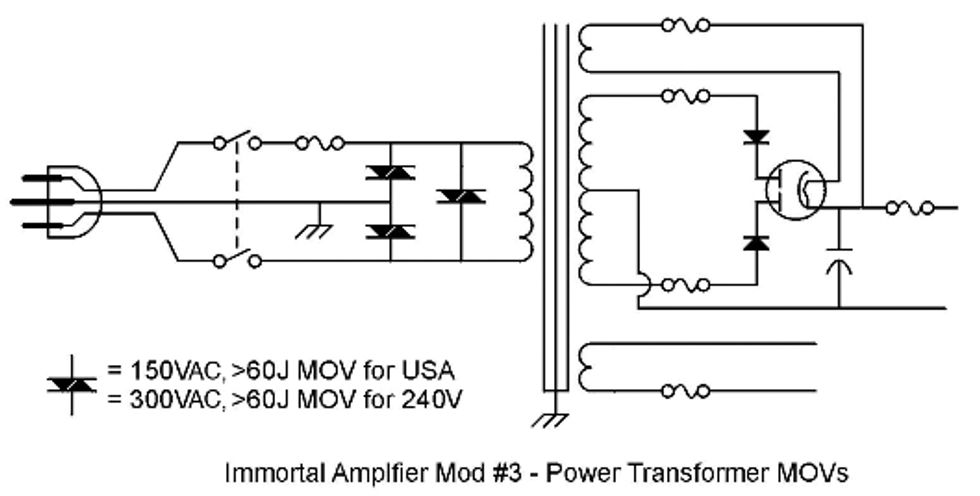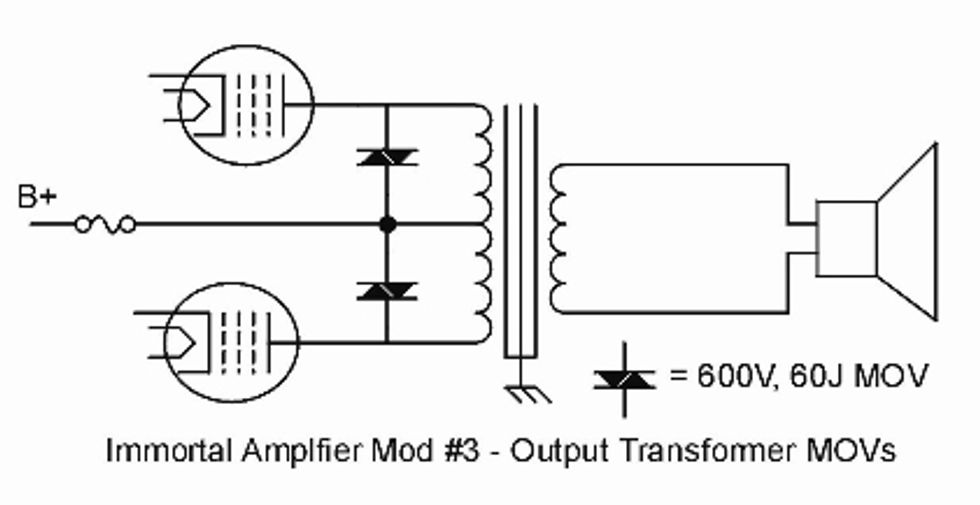Any time you combine electricity and coils of wire, you have the potential to cause sharptoothed electrical spikes that can puncture insulation and cause shorts. Fortunately, we have the ability to stop them cold.
Immortality Mod #3: Stop transient spikes Our AC power lines get more polluted every day with the leftovers of all the electronics and mechanical equipment that run on them. There’s also the infrequent but real danger of a nearby lightning strike on the AC power lines putting a big spike into your amp.
Here’s a quick cure to make this a non-problem in your amp. Buy three “MOV” varistors for around $0.50 each and install one from each AC power line to the safety ground wire. Put the third one between the two AC power wires. Even if you pay a tech to do this for you, the cost is almost entirely for the tech’s time to do it correctly and safely.
Warning! These mods are in the highest voltages in the amplifier. If you want to do this yourself, you must be absolutely certain before you start that you already know how to do it safely. If you have any doubts at all, take it to a tech that can do it safely. Also, always unplug your amp for at least several minutes before opening it!
 |
This is what is inside most surge protection power strips. Of course you could always use a protected power strip, but you have to remember it every time.
Electrical spikes are so common that there are special parts made to protect against them. The simplest of these is the metal oxide varistor, or MOV for short. A MOV is a chunk of powdered metal oxides pressed together and semi-melted into a solid disc, with leads on each side of the disk. The oxides don’t conduct very well until the voltage across the disc gets high enough, then it suddenly snaps into conduction and can eat huge amounts of electrical power. When it conducts, it eats the excess voltage until things get back down to normal, then it turns off.
For AC power line protection, use MOVs rated for more than the line voltage. In the U.S., the nominal AC voltage is 120V, but I often see it between 125 and 130VAC. There
are 130VAC-rated MOVs, but there is not enough margin between the 130VAC rating and the close-to-130VAC line – use MOVs rated for at least 150VAC. As an example, at
the time of this writing, Mouser Electronics lists the Littelfuse 14V150 MOV as 150VAC, 200VDC, and capable of clamping a peak current of 6000 amperes! It’s a tough little device and it sells for $0.35 as of deadline.
There’s another source of spikes in your amplifier – the output transformer. It’s an electrical coil of wire, too. It can make insulation-puncturing spikes very effectively under certain conditions. However, in this position in the amp, what it kills most often is itself.
 |
You get output transformer spikes when current in the transformer is suddenly interrupted. It is unusual for the tubes themselves to be able to turn the transformer off fast
enough to cause spikes, even in failing, but a wire breaking or a speaker suddenly unplugged can do it.
Some amps have a string of diodes from signal ground to the plates of the output tubes for just this reason. It’s a clever idea, but it suffers from relying on the opposite side
of the output transformer to do the protection. The leakage between the two primary sections is one of the places that can generate spikes.
If we place a MOV from one output tube plate to the other, across the output transformer primary, the problem is solved directly. One MOV between each primary lead and the center tap of the output transformer clamps any transient that is larger than B+ and eats the excess energy. In normal operation, the MOV cannot conduct, so normal operation is not changed.
The skeptic would ask me, “Well, my vintage Fender-Marshall-Gibson is over 40 years old and still running. It doesn’t have all that fancy stuff. How come we need that now?” My answer is that there would not be companies making replacement power and output transformers if they were not needed; having been lucky before does not guarantee
you’ll always be lucky.
R.G. Keen
Chief Engineer
Visual Sound
www.visualsound.net













![Rig Rundown: Russian Circles’ Mike Sullivan [2025]](https://www.premierguitar.com/media-library/youtube.jpg?id=62303631&width=1245&height=700&quality=70&coordinates=0%2C0%2C0%2C0)





